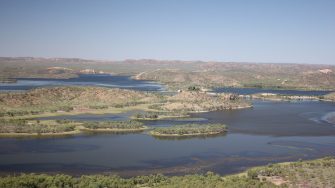
Date: Thursday, October 6, 2016
Project: Eastern Australian Waterbird Survey
Observer: Richard Kingsford
West today to Mt Isa – surveying all of the wetlands and rivers for their waterbirds, along our most northerly survey band 10. Each of our survey bands is 30 km wide running east to west with every major wetland and river marked and surveyed.
The new NSW National Parks and Wildlife Cessna 206 has all the best navigation equipment.
First large wetland to be surveyed was Proserpine Dam, built in 1990 to regulate and capture flows in the Proserpine River. This inevitably means less water on the floodplain downstream where we surveyed yesterday. This is not compensated by either the number of waterbirds on Proserpine Dam or the types of birds on the dam.
We come up over the dam wall and survey the southern shoreline of Proserpine Dam
The dam was surprisingly not full, not the pattern we have seen over the last few days. Many farm dams west of the large dams were also either half full or dry, emphasising the dryness. Proserpine Dam had flocks of hundreds of cormorants and smaller flocks of pelicans. There were also egrets and black swans but relatively few ducks.
Surveying the southern shoreline, where the waterbirds concentrate on Proserpine Dam.
From here over the coal mining town of Collinsville and along the rivers joining the Burdekin River. The first is one of my scenic favourites – the Bowen River. Its long pools and sand bars are stunning, with the bonus of seeing black-necked storks along the way.
The Bowen River in the dry season dries back to a series of long waterholes, interrupted by sand bars (excuse the blotch-insect strike - this is always an occupational hazard on low level surveys).
The next is the stunningly beautiful Burdekin River with its red rocks, gravel and sand bars. The only nagging downside is that this magnificent river is regulated by the Burdekin Falls Dam. So the flows regime has changed considerably and we notice this immediately with water pouring down the river to supply irrigation areas downstream. Waterbirds are few and far between – pelicans, darters, egrets and the odd black-necked stork.
Surveying the Burdekin River, regulated by the Burdekin Falls Dam upstream and also regulated by a small weir.
Today I saw more sea eagles (about six) than I have ever seen on this river. We continued south all the way over the wall of Burdekin Falls Dam which holds water back from the Burdekin River. The dam is extremely large storing 1,860,000 ML, over an area of 220 ha. It was almost full. Despite this huge area of potential waterbird habitat, we saw no more than about 50 waterbirds, mostly pelicans and cormorants, underlining the poor habitat quality of dams.
Flying up the Burdekin River and over the wall of the Burdekin Falls Dam dam.
We refuelled at Hughenden before heading over the Flinders River and the other rivers that flow to the Gulf of Carpentaria. This with the northern Mitchell River is part of the new frontier for water development in Northern Australia, sanctioned, promoted and supported financially by all recent governments. Here we saw our first areas of irrigation development, one for cotton irrigated from a large off river storage. The massive developments in the northern Murray-Darling Basin started similarly in the early 1990s and now capture much of the unregulated flows, severely affecting downstream ecosystems and communities.
Irrigation areas along the Flinders River
Further west, river beds criss cross, weaving intricate patterns across the landscape. Now in the dry season they are mostly just wide ribbons of sand but they must be a sight to see in the wet, pouring into the Gulf of Carpentaria. A few still hold water from the last flood but relatively few waterbirds here, except for small flocks of brolgas.
One of the few waterholes near Julia Creek, still holding water.
The wide Cloncurry River, now with a dry sandy bed, flows to join the Flinders River before flowing out into the Gulf of Carpentaria.
Our last major wetland to survey was Lake Moondara, Mt Isa’s water supply. In previous years, this has teemed with waterbirds, numbering in the tens of thousands. We predicted numbers should be relatively low, given the extensive wetland areas to the south in the Lake Eyre Basin. Also, most dams usually offer suboptimal habitats for waterbirds. We weren’t wrong. There were only a few hundred birds – mainly cormorants and pelicans.
Surveys of Lake Moondara hug the shoreline where most of the waterbirds usually feed.
